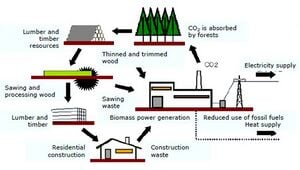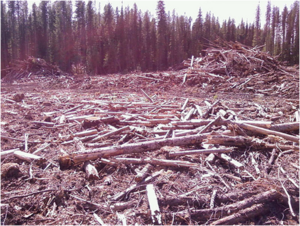
Biomass Energy in Humboldt County
Biomass
An energy resource derived from organic matter. This includes wood, agricultural waste and other living-cell material that can be burned to produce heat energy. Also included is algae, sewage and other organic substances that may be used to make energy through chemical processes.
Forest Residues
Forest harvesting is a major source of biomass for energy. Harvesting may occur as thinning in young stands, or cutting in older stands for timber or pulp that also yields tops and branches usable for bioenergy. Harvesting operations usually remove only 25 to 50 percent of the volume, leaving the residues available as biomass for energy. Stands damaged by insects, disease or fire are additional sources of biomass.
Some Pros and Cons of Biomass Power Plants[edit | edit source]
Pros
- Renewable source of energy
- Although co2 is released, it is “carbon neutral” which means co2 released is equal to the co2 that *was taken in during its life cycle.
- Helps to reduce dependency on foreign oil. *(Doesn’t account for obtaining biomass, or transport of the biomass to plant.)
- Can generate electricity at any time day or night, doesn’t need sun or wind.
Cons
- Little to no variation in amount of power generated- plants cannot greatly increase production to meet peek demands.
- Emissions-particulates, CO, CO2, NOx
- If too much dead wood is taken out of forests it can be detrimental to forest sustainability.
- Loss of soil nutrients
- Loss of wildlife habitat
- Loss of forest carbon storage
http://web.archive.org/web/20150217031441/http://www.novascotiaforests.ca:80/

3 Biomass Plants in Humboldt County[edit | edit source]
Blue Lake Power LLC
Blue Lake, Ca
- Has not been operating since 1999
- Blue Lake Power has the potential for 90,000,000 kWh per year, which will require 190,000 green tons of biomass fuel.
- They currently have all their updated permits and stockpiles of fuel, they are just waiting for financing.
- Plan to rely heavily on forest thinning and other resources rather than saw mills.
But… When Blue Lake Power does begin operating they will be in a 10 year contract with San Diego Gas & Electric.
http://ucanr.org/blogs/WoodyBiomass/index.cfm?tagname=power
http://docs.cpuc.ca.gov/published/Final_resolution/94355.htm
Fairhaven Power Company
Eureka, Ca
- Produces 120,000,000 kWh per year.
- Use 260,000 green tons per year of wood waste. Been operating biomass plant for 22 years.
- Fuel sources include; bark, sawdust, wood chips, and wood shavings, which are mostly obtained from sawmills.
- Have an 18 year contract with PG&E.
- They recycle their leftover ash by giving it to local dairy farmers to try and preserve the land.
http://investing.businessweek.com/research/stocks/private/snapshot.asp?privcapId=22037315
Pacific Lumber Company (Palco)
Scotia, Ca
- In 2005 generated 22 MW of power to PG&E
- In 2005 consumed 700,000 tons of green waste per year.
- Initially produced biomass fuel solely from their own left over scraps so they could become self-sufficient.
- In 2007 Palco saw a 75% reduction in their internal supply for fuel so they were forced to outsource from other mills and resources, some up to 200 miles away.
- With many mills in this area closing, the biomass plants become less profitable because transportation costs begin to exceed the profits.
Biomass Operations[edit | edit source]

Harvesting operations in forestry- utilize only main stem of tree. Branches and leaves, known as Slash, are left over after harvesting operation and in most cases is scattered and/or burned. Foresters are concerned with utilizing the excess woody biomass that creates:
- high fuel hazard in the forests and urban/wildland regions of Northern California.
The carbon dioxide released when burning wood (about 4.2 lbs of CO2 for each 2.2 lbs of wood burnt)[2]
1 truck load can carry 16 tons of biomass which is worth $700 and is equivalent to 44 of barrels of oil (by mass), worth ~$3000[3]
A key attribute of biomass is its availability upon demand-the energy is stored within the biomass until it is needed. Other forms of renewable energy are dependent on variable environmental conditions such as wind speed or sunlight intensity.[4]
In terms of carbon neutrality, the burning of wood often ignores the fossil fuel used in the harvesting, preparation and transporting of the wood.

Green Diamond Resource Co.

Green Diamond is working with biomass operations manager Steve, who is in charge of post-harvesting biomass operations East of Mckinleyville. Steve has come up with an innovative technique for making these operations economically viable. Transportation of biomass or wood chips is costly and in some cases not feasible. Harvesting operations take place deep in the forest where access roads are narrow dirt roads with sharp corners. Instead of the semi trucks, which haul the wood chips, driving all the way to the harvest unit, Steve designed a centralized location where the biomass operations occur. Dump trucks are used to haul the slash to this centralized landing, where the slash is chipped and then hauled to energy plant. The further the landing is from the harvest site the more dump trucks used to haul slash. What this does is keeps the wood chipper and the trucks hauling the wood chips running constantly. When one piece of equipment is not producing, then money is being spent on nothing. In order for these operations to be economically viable all pieces of equipment must be running at all times, as well as energy plants being close enough to centralized operation landing.
References[edit | edit source]
- ↑ Alternative Energy News
- ↑ Martin Crawford, Agro forestry Research Trust. Is Burning Wood Really A Long-Term Energy Descent Strategy? 19 May 2008
- ↑ Biomass operations manager: Steve
- ↑ U.S. Department of Energy, Energy efficiency and Renewable energy